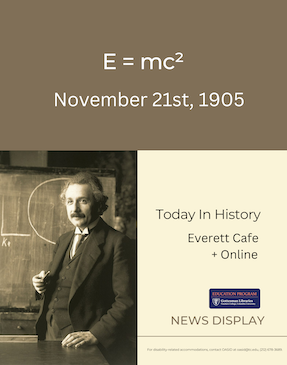Today in History: E = mc²

IN your schooldays most of you who read this book made acquaintance with the noble building of Euclid’s geometry, and you remember—perhaps with more respect than love—the magnificent structure, on the lofty staircase of which you were chased about for uncounted hours by conscientious teachers.
Part I: The Special Theory of Relativity, Albert Einstein
On November 21st, 1905, German-born theoretical physicist Albert Einstein (1879-1955) proposed that energy and mass (matter) are interchangeable or different forms of the same thing. Energy turns into mass, and mass turns into energy; while mass is not conserved on its own, extracting energy from mass is essential for the Universe. His theory was expressed in an article entitled, Ist die Trägheit Eines Körpers von Seinem Energieinhalt Abhängig? (Does the Inertia of a Body Depend Upon Its Energy-Content?), published in Annalen der Physik. That same year, Albert Einstein obtained a doctorate. Unable to find a teaching position, for years he worked as a Technical Assistant in a Swiss Patent Office, until he was appointed Privatdozent in Bern -- after which came a series of academic appointments before he emigrated to the United States where he then became Professor of Theoretical Physics at Princeton University.
Albert Einstein is best known for his theory of relativity and his important contributions to quantum mechanics. His mass energy equation is regarded as perhaps the world's most famous equation, to be developed over subsequent years. Einstein's theory paved the way for further research and inspired scientists and others to look more closely at the laws of physics, and help us ultimately understand our place in the universe , not to mention our daily living: for example, things that are still in space still move in time; stars transform their mass back into energy through heat and light; and cars burn gasoline to generate movement. In 1921, he won the Nobel Prize in physics. Einstein's works include Relativity: The Special and General Theory, A Popular Exposition (1920), Investigations on the Theory of Brownian Movement (1926), The Evolution of Physics (1938), About Zionism (1930), Why War? (1933), and Out of My Later Years (1950).
The following articles are drawn from Proquest Historical Newspapers, which informs and inspires classroom teaching and learning:
- Dr. Albert (E=MC²) Einstein; American. (1955, Apr 19). Newsday (1940-)
- Sullivan, W. S. (1972, Mar 28). The Einstein Papers: A Flash of Insight Came After Long Reflection on Relativity: The Einstein Papers. New York Times (1923-)
- Books: The Universe According to Einstein. (1979, Mar 25). The Sun (1837-)
- Collier, B. (1979, Jul 01). Einstein's Theory of Free Men: Citizenship Is a Moral Choice, Said the Genius Who Sought U.S. as His Refuge. Boston Globe (1960-)
- Coigligh, S. O. (1979, Aug 25). Einstein and the Big Bang. The Irish Times (1921-)
- Toner, M. (1983, Apr 03). Einstein's Literary Legacy Finally to See Light of Day. The Hartford Courant (1923-)
- Price, H. (1996, Oct 01). E=mc 2 Is Formula for Success Among Black Youth. Philadelphia Tribune (1912-)
- E=mc: Einstein Deciphered the Mysteries of the Universe for Every Scientist in the World: Isn't It About Time Someone Deciphered Them for You. (1998, Feb 24). The Christian Science Monitor (1908-)
- Goldman, A. (1999, Nov 05). Einstein Unveils the Secrets of Physics. Los Angeles Times (1996-)
- 103 Years On, E= mc² Is Proved Right. (2008, Nov 22). The Times of India (1861-2010)

Tips:
- Einstein, Albert, and Amanda Shaffer. The Albert Einstein Collection : Essays in Humanism, the Theory of Relativity, and the World as I See It. New York, New York: Philosophical Library, 2011. e-book
- Garvey, Brian. Physics : Understanding the Properties of Matter and Energy. Ed. John Murphy and Hope Lourie Killcoyne. First edition. New York: Britannica Educational Publishing, 2015. e-book
- Marco, Mamone Capria. Physics Before and After Einstein. Amsterdam: IOS Press, 2005. e-book
- Wadia, S. R. (Spenta R.). The Legacy of Albert Einstein a Collection of Essays in Celebration of the Year of Physics. Singapore ; World Scientic, 2007. e-book
Images:
- E equals MC Square Explained, Courtesy of Wikimedia Commons
- Poster Image: Albert Einstein During a Lecture in Vienna in 1921, by Ferdinand Schmutzer, Courtesy of Wikimedia Commons
Need to keep current, look to the past, teach a topic? The Everett Cafe features daily postings of news from around the world, and also promotes awareness of historical events from an educational context. Be sure to check additional Cafe News postings on the library blog.

